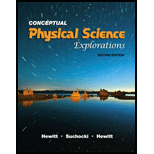
In terms of the periodic table, is there an abrupt or gradual change between ionic and covalent bonds?
(a) An abrupt change that occurs across the metalloids.
(b) Actually, any element of the periodic table can form a covalent bond.
(c) There is a gradual change: the farther apart, the more ionic.
(d) Whether an element forms one or the other depends on nuclear charge and not the relative positions in the periodic table.
The correct option for the statement “In terms of the periodic table, is there an abrupt or gradual change between ionic and covalent bonds?”
Answer to Problem 5RAT
The correct option for the statement “In terms of the periodic table, is there an abrupt or gradual change between ionic and covalent bonds?” is option (c).
Explanation of Solution
Atom is neutral and contains zero overall charge. When there is a net charge on an atom, it is called as an ion.
The positively charged ions are formed when an atom gives out electrons. The negatively charged ions are formed when an atom accepts electrons.
The ions having opposite charge than each other attract and form the ionic bond. The ionic compounds contain the ionic bonds. The transfer of electrons take place in an ionic bond. Atoms with a big difference in electronegativities form ionic bonds.
The electron sharing occurs in covalent bonding.
The atoms with higher difference in their electronegativities, form more ionic compounds. The electronegativity is a periodic trend. It increases from left to right in a period and decreases down the group.
So, the atoms which are situated farther apart have large difference in their electronegativities and so are more ionic.
Conclusion:
Therefore, the correct option for the statement “In terms of the periodic table, is there an abrupt or gradual change between ionic and covalent bonds?” is option (c).
Chapter 18 Solutions
Conceptual Physical Science Explorations
Additional Science Textbook Solutions
Essential University Physics (3rd Edition)
University Physics with Modern Physics (14th Edition)
College Physics
University Physics Volume 1
Conceptual Physical Science (6th Edition)
Conceptual Physics (12th Edition)
 College PhysicsPhysicsISBN:9781305952300Author:Raymond A. Serway, Chris VuillePublisher:Cengage Learning
College PhysicsPhysicsISBN:9781305952300Author:Raymond A. Serway, Chris VuillePublisher:Cengage Learning University Physics (14th Edition)PhysicsISBN:9780133969290Author:Hugh D. Young, Roger A. FreedmanPublisher:PEARSON
University Physics (14th Edition)PhysicsISBN:9780133969290Author:Hugh D. Young, Roger A. FreedmanPublisher:PEARSON Introduction To Quantum MechanicsPhysicsISBN:9781107189638Author:Griffiths, David J., Schroeter, Darrell F.Publisher:Cambridge University Press
Introduction To Quantum MechanicsPhysicsISBN:9781107189638Author:Griffiths, David J., Schroeter, Darrell F.Publisher:Cambridge University Press Physics for Scientists and EngineersPhysicsISBN:9781337553278Author:Raymond A. Serway, John W. JewettPublisher:Cengage Learning
Physics for Scientists and EngineersPhysicsISBN:9781337553278Author:Raymond A. Serway, John W. JewettPublisher:Cengage Learning Lecture- Tutorials for Introductory AstronomyPhysicsISBN:9780321820464Author:Edward E. Prather, Tim P. Slater, Jeff P. Adams, Gina BrissendenPublisher:Addison-Wesley
Lecture- Tutorials for Introductory AstronomyPhysicsISBN:9780321820464Author:Edward E. Prather, Tim P. Slater, Jeff P. Adams, Gina BrissendenPublisher:Addison-Wesley College Physics: A Strategic Approach (4th Editio...PhysicsISBN:9780134609034Author:Randall D. Knight (Professor Emeritus), Brian Jones, Stuart FieldPublisher:PEARSON
College Physics: A Strategic Approach (4th Editio...PhysicsISBN:9780134609034Author:Randall D. Knight (Professor Emeritus), Brian Jones, Stuart FieldPublisher:PEARSON





